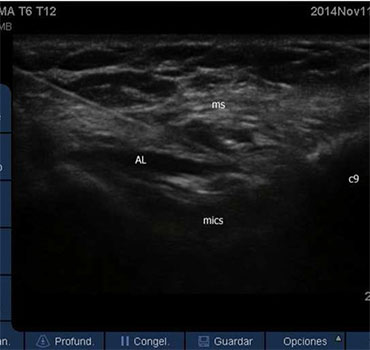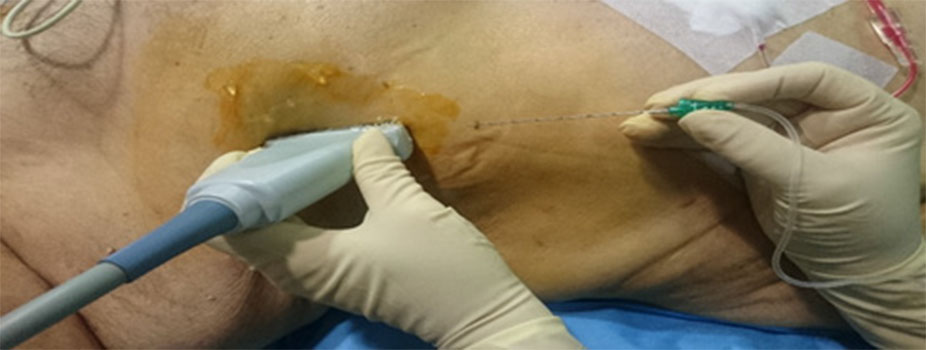Previous Issues Volume 1, Issue 1 - 2017
Ultrasound-Guided Intercostal Nerves (Cutaneous Branches) Block: Analgesic Alternative in Open Surgery Gallbladder
Maria Teresa Fernandez Martin1
Department of Surgery, Hospital Medina del Campo, Spain.
Corresponding Author:María Teresa Fernández Martín, Department of Surgery, Hospital Medina del Campo, Valladolid, Spain, Tel:+34637571685; E-Mail: [email protected]
Received Date: 09 Jan 2017 Accepted Date: 30 Jan 2017 Published Date: 03 Feb 2017
Copyright©2016 Martin MTF
Citation:Martin MTF. (2017). Ultrasound-Guided Intercostal Nerves (Cutaneous Branches) Block: Analgesic Alternative in Open Surgery Gallblader. Mathews J Anesth. 1(1): 004.
ABSTRACT
Laparoscopic cholecystectomy has become the standard treatment for gallbladder diseases. However, there still are some patients for whom conversion to open surgery is required. This surgery generates a very important postoperative pain. Traditionally, the opioids drugs have been the treatment for this pain, but side effects have led to seek alternatives (plexus, nerve or fascia blocks). We present 8 patients with intercostal branches block ultrasounds in the mid-axillary line from T6 to T12 with levobupivacaine like analgesic alternative in open surgery of gallbladder, with satisfactory results.
KEYWORDS
Open Cholecystectomy; Postoperative Pain; Intercostal Nerves; Levobupivacaine; Ultrasonography.
SHORT COMMUNICATION
The open cholecystectomy makes a right subcostal incision, resulting a severe intensity postoperative pain, leading to a slow recovery [1]. Although the laparoscopic approach is the standard treatment for gallbladder diseases, various reasons (technical difficulties, bleeding, biliary tract injury) make it necessary to resort to a conversion of technique (between 0.8 and 12% according to different studies). Opioids have been used for good analgesia after open cholecystectomy, but adverse effects caused by the same limited their utilization [2]. The scientific evidences support the use of analgesic strategic multimodales [3]. combining oral or intravenous drug therapy and loco regional analgesia techniques, with local anaesthetic administration at central (spinal, paravertebral), cavity (interpleural), or peripheral(intercostal nerves and/ or surgical wound). The use of these latest techniques has shown a better pain control and a lower consumption of opioids (with the consequent decrease of the side effects that are associated) [4]. The upper abdominal wall innervation (skin and muscles) depends of intercostal nerves (T6-T12), our proposal is based in the ultrasound-guided fascial block of these nerves by a single puncture at middle axillary line (BRILMA modified) to prevent pain (visceral- peritoneum) we treat with non-opioid analgesics. The BRILMA was described the first time in 2012, blocking the branches of Intercostal nerves in the Middle Axillary line (cutaneous branches lateral and anterior) for non-reconstructive breast surgery [5, 6]. The authors always performed under ultrasound guidance, the objective is to place the local aesthetic in the plane between the medial aspect of the serratus anterior muscle and the external intercostal muscle. They introduce the needle in plane and placed the tip at the level of the 4th rib approximately and the results are good. Building on the concept of fascial lock and our experience to perform the BRILMA for breast surgery, we carry out a blockade of the lateral and anterior cutaneous branches of intercostal nerves in the maxillary line in our patients with open cholecystectomy. With the patient supine and the linear ultrasound probe in sagittal plane, the needle 21G 30th 85mm (Locoplex® Vygon, France) in plane caudal-cranial to 1cm of the probe is inserted. Seeing the spread through the fascial space between both muscles, repositioning the needle if it not was effective, and placing a total of 3 ml of local aesthetic to each segment we want to block (Figures 1 and 2) It allows the blockade of the previous branches and wings of the intercostal nerves between 6º and 11º intercostal spaces, that although they intermingle with adjacent nerves producing overlap of innervation, they get Anesthesia of skin and abdominal wall muscles.
Figure 1:Ultrasound image: C9: 9th rib; mics: intercostal muscles; ms: serratus muscle; AL: local anesthetic.
Figure 2: Ultrasound image: diffusion of the aesthetic in fascial plane..
At the last year we have applied the BRILLMAN modified in 8 patients and we have checked the efficacy of our block in the multimodal strategy, because it permitted decrease the opioids doses. Our patients have been 5 males and 3 females, with a middle age of 79 years. The most of cases have been reconversion of the laparoscopic technique, so that we have blocked them before wake up the patient. To all the patients we performed a balanced Anesthesia. The induction has been made with propofol and the maintenance with sevorane. Like intraoperative analgesia we used fentanyl. And at the postoperative time we used an analgesia pauta of paracetamol 1gr and dexketoprofen 50 mg intravenous, alternate every 4 hours. For analgesic rescue has been used the pethidine 50 mg intravenous. The efficacy of the analgesic treatment was evaluated in the first 72 hours. After surgery, the patients were admitted for 2 hours in the post-aesthetic unit. Your VAS (visual analog scale) to income was 3-4, and at leaving the most had 0-2 WAS. Nobody needed analgesic rescue. In the first 24 postoperative hours only two patients needed methadone like analgesic rescue. The other 6 patients had pain controlled (VAS <3) with the scheduled analgesia. 5 of the 8 cases began to eat and to walk 24 hours after surgery. So that, we are talking about a new way to block intercostal nerves with a single puncture ecoguide, safely and easily, placing the local aesthetic into the space between the serratus muscle and external intercostal muscles. Within a multimodal strategy, the results obtained at these 8 patients are satisfactory but we need more patients and comparative studies with others techniques, to insure this block as an analgesic alternative in open cholecystectomy.
REFERENCES
- David Mc Aneny. (2008). Open Cholecystectomy. Surg Clin N Am 88: 1273- 1294.
- Joshi GP, Schug SA and Kehlet H. (2014). Procedurespecific pain management and outcome strategies. Best Pract Res Clin Anaesthesiol. 28: 191-201.
- Richman J, Spencer S, Courpas G,Wong R, et al. (2006). Does continuos peripheral nerve block provide superior pain control to opiods? A meta-analysis. Anesth Analg. 102: 248-57
- Santeularia Verges MT, Catala Puigbo E, Genove Cortada M, Revuelta Rizo M, et al. (2009). Nuevas tendencias en el tratamiento del dolor postoperatorio en cirugia general y digestiva. Cir Esp 86: 63-71.
- Fajardo Perez M, Garcia Miguel FJ, Lopez Avarez S, Dieguez GarcIa P, Alfaro de la Torre P. (2012). Bloqueo de las ramas cutAneas laterales y anteriores de los nervios intercostales para analgesia de mama. Cir May Amb. 17: 95-104.
- GarcIa Dieguez P, Fajardo Perez M, Lopez Alvarez S, Alfaro de la Torre P, et al. (2013). Abordaje guiado por ultrasonidos de los nervios intercostales en la linea media axilar para cirugia de mama no reconstructiva y de la axila. Rev Esp Anest Reanim. 60: 365-370.

